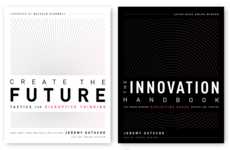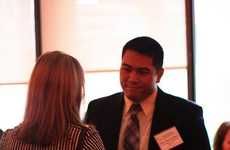Senduran Bhakthakumaran — March 26, 2012 — Business
References: adriangostick
Adrian Gostick is a worldwide thought leader in workplace strategy and employee engagement. He is a New York Times bestselling author who has worked collectively on award-winning novels such as ‘The Carrot Principle’ and ‘The Orange Revolution.’ He founded ‘The Culture Works,’ a firm geared towards international training and consulting. His work has been deemed “admirable and startling” by the Wall Street Journal and he continues to enlighten the world throughout his latest novel ‘All In.’
16 Questions with Adrian Gostick
1. Do you need a culture of revolution in order to be successful?
In our last book we wrote about Orange Revolutions—or how individual teams can create breakthrough results in even the toughest corporate climates. But over the last few years something has changed. As we meet with new clients, expecting them to want us to work with them on focused ideas like creating breakout teams, they keep steering the conversation back to culture. And not just their overall corporate culture; they have awoken to the fact that if the culture in their Cincinnati or Dubai office isn’t working, then no amount of esprit de corps will help. They have learned that if a culture works, then everything works better.
So certainly some teams have to have a revolution of sorts to break out of mediocrity, our research is now on a larger scale. It shows that it is possible to transform your workplace into a culture where employees are All In, where they believe what they do matters and they can make a difference.
We’ve all heard about the power of the great cultures at Google, Apple, Zappos, and so on—now there’s proof that those cultures really pay off for shareholders. The survey in our new book All In shows financial results in companies with great cultures are three times higher than in peer companies—not three percent higher, but three times higher. In these types of places, people buy into mission and values, and really care about serving their clients and making the company a success.
2. What is the biggest leadership mistake?
The biggest misstep many managers make is failing to understand the influence they really have on workplace engagement and performance. In our consulting work we are often faced with quantifying how much sway managers really have over performance. Sometimes leaders doubt if it is in their power to influence morale, productivity, and profitability. They know some work groups perform better than others, but it is difficult to pinpoint the exact reasons why and even a little uncomfortable to wonder if it is within their power to shape success. But our work shows unequivocally, managers make the difference.
Whether you manage the smallest of teams or a multi-continent organization, you own of a culture, and it’s important to understand that the effectiveness of that culture will have a big impact on your performance. If your culture is clear, positive, and strong, then your people will buy into your ideas and cause and, most importantly, will believe what they do matters and that they can make a difference.
3. How important is collaboration in the workplace?
To survive as a species, human beings must depend on each other. Translated to business, the rule is: A leader can’t go it alone. Rudyard Kipling spelled it out succinctly and poetically in his classic The Jungle Book:
The strength of the pack is the wolf,
And the strength of the wolf is the pack.
And yet many teams in today’s companies are not true teams at all; they’re faux. Organizationally, structurally, motivationally, they are not set up to work together effectively. They’re simply vague labels placed on random groupings, or even the entire organization as a whole. Someone has told leadership that they should have teams, and so they have them. But employees are not fooled. They continue to be groups or departments of people that simply have the blanket of “team” thrown upon them. Take a peek underneath and you’ll find a group of individuals largely fending for themselves.
The reality in the most successful companies is very different. Here’s what great leaders do: they build great teams.
4. In your latest book 'All In,' you discuss leadership and how to drive big results. What is one of the most impactful takeaways from this publication?
For the book Towers Watson provide us with data from a 300,000-person study—all to determine what levers managers of the most successful organizations pulled to bring about such dramatically better financial results than their peers and how they did it during the abysmal market conditions we experienced during the last few years. The core finding was that in the highest-performing cultures, leaders not only create high levels of employee engagement—strong attachment to the company and a willingness to give extra effort—but they also create environments that support productivity and performance, in which employees feel enabled. And finally, managers help employees feel a greater sense of well-being and drive at work; in other words their people feel energized.
From the research we developed a manager’s practical guide to developing a culture where people buy in:
Define your burning platform. Defining mission and values with great clarity, and also instilling a sense of urgency.
Create a customer focus. Helping employees focus like lasers on customer needs, which helps employees take initiative on their own.
Develop agility. Address coming challenges and capitalizing on new opportunities.
Share everything. Becoming a place of truth, constant communication, and marked transparency.
Partner with your talent. Having a sincere desire to create opportunities for employees to grow and develop—retaining the best.
Root for each other. Providing much greater levels of peer-to-peer and top-down appreciation and camaraderie.
Establish clear accountability. Turing accountability from a negative into a positive.
5. How did you get involved in management and what motivates you to continue?
About 15 years ago, my co-author Chester Elton and I were working for a consulting company. We were doing some pretty cool things on recognition and employee engagement with clients, and Chester had the idea that we should capture it in a book. No one had ever written the definitive work on employee recognition, and we were able to do that with The Carrot Principle. What keeps us going is getting to work with amazing clients around the world, and at least weekly getting an email or letter from a manager who says they have changed the way they lead because of our books. That’s the best part of our job.
6. How significant are the topics of cool hunting and trend spotting in the world of management and leadership?
In one way, good leadership is very similar to what it was decades ago—you listen, you respect, you set goals, you communicate, you recognize. However, in this economy, our research shows the best managers are also much more “agile.” They are much better at helping their employees spot trends, threats and opportunities on the horizon. And as a result, their teams are vastly more successful than their traditional peers.
7. How do you define a trend?
In leadership, a trend is something that is producing tangible results for real managers, something that is shifting because of changes to the marketplace. For instance, technology has become a powerful mechanism for facilitating what we call 360-degree listening—especially when controls from above are relaxed. Technology in and of itself does not necessarily increase agility, but we have visited numerous companies that use social networking portals on their intranets to encourage employees to exchange knowledge and innovative ideas. Some common forms of collaboration online include file sharing, wiki sites, blogging, and forums.
8. How do you define cool?
The other day I told my 16-year-old I’d just bought a new stadium chair to more comfortably watch his soccer games. His response, “That’s probably the saddest thing I’ve ever heard.” So what’s cool? Not me. But I surround myself with very cool people doing very cool things—designers, researchers, fellow writers, musicians, and so on. To me, cool is something that helps you accomplish something practical—like sell a product or introduce an idea—but in an unexpected, eye-catching and immensely memorable way. It typically involves humor.
9. Do you need a culture of innovation to create something that is cool?
Typically. The problem is, most corporations only allow true innovation to flourish for so long before they squash it. One senior leader at a Fortune 10 firm told me this, “Eventually we take all creativity and attempt to bring it back into the fold. We can’t help ourselves. That’s what we do.” The best organizations allow select employees to push the organization out of its comfort zone in meeting the needs of clients.
10. What is the best way to create an infectious idea, product or service?
In the most innovative cultures we’ve studied, leaders have taken select numbers of enterprising employees out of their normal jobs for a time and asked them to push the entire organization forward. These top performers are given permission to disrupt and innovate with the customer in mind.
While rules-based companies tend to operate according to the principle that everyone at the various levels and in the various functions adds value about equally, the fact is there are employees at all levels who are higher performers, and it’s these people who are often the most connected to your customers—they have learned how to provide valued service and they will bring the most creativity and innovative thinking to creating an infectious idea, product or driving a customer-enhancement service.
11. What is the key to innovation?
I think there are a lot of keys, but one of the most overlooked is fun. The work world isn’t suffering from a dearth of tedious, go-nowhere, stiff brainstorming sessions. Just a spoonful of levity can spur breakout success. Research shows that you can boost scores on creativity tests by exposing people to humor or other conditions that establish a “playful atmosphere.” Want to amp up innovation? Take a toy break, play a game, or watch a few minutes of funny YouTube videos as a group. Seriously.
12. What are your ambitions for ‘All In’?
Many managers right now are facing indifference or resistance in their teams. Their particular situation may seem impossible, inexorable. It is not. There is a path to a hidden reservoir of drive and dedication in your people. We know All In can help millions of real leaders develop stronger cultures and tangible business results.
13. What is an example of a time where you have thrown away an existing idea to force yourself to find something new?
When we submitted All In to our editor at Simon & Schuster, the book had a different title and a much different direction. Four months of painstaking work later, our editor was finally happy. It entailed throwing away a year’s worth of work and basically starting over, but our editor said, “I’m good at what I do. I’ve been doing this a long time. I take the most time with books that I think will have a big impact on the world, and I need you to trust me.” We did, and it’s paid off. It’s our best work ever, but it took a lot of rework and listening. The greatest danger we all have is thinking our first effort is our best.
14. How do you reset yourself to be creative? Do you have any rituals?
I need solitude to write creatively, but I need collaboration with creative, funny, non-morose people to do strategic work. I guess it depends on what I’m working on.
15. Professionally, what do you want to be doing or studying in 10 years?
That’s a long time out. I don’t think we can set goals that far anymore, since things are changing so fast. In the next few years our work will focus on the role of the individual. We have studied managers, teams, and now cultures—the next place to go is to the heart of the matter, the person, the employee, the individual.
16. What are your most important hobbies?
I love to watch my son play soccer—he is the world’s greatest 16-year-old soccer goalkeeper, or at least I think so. And one day I’ll finish my historical novel.
16 Questions with Adrian Gostick
1. Do you need a culture of revolution in order to be successful?
In our last book we wrote about Orange Revolutions—or how individual teams can create breakthrough results in even the toughest corporate climates. But over the last few years something has changed. As we meet with new clients, expecting them to want us to work with them on focused ideas like creating breakout teams, they keep steering the conversation back to culture. And not just their overall corporate culture; they have awoken to the fact that if the culture in their Cincinnati or Dubai office isn’t working, then no amount of esprit de corps will help. They have learned that if a culture works, then everything works better.
So certainly some teams have to have a revolution of sorts to break out of mediocrity, our research is now on a larger scale. It shows that it is possible to transform your workplace into a culture where employees are All In, where they believe what they do matters and they can make a difference.
We’ve all heard about the power of the great cultures at Google, Apple, Zappos, and so on—now there’s proof that those cultures really pay off for shareholders. The survey in our new book All In shows financial results in companies with great cultures are three times higher than in peer companies—not three percent higher, but three times higher. In these types of places, people buy into mission and values, and really care about serving their clients and making the company a success.
2. What is the biggest leadership mistake?
The biggest misstep many managers make is failing to understand the influence they really have on workplace engagement and performance. In our consulting work we are often faced with quantifying how much sway managers really have over performance. Sometimes leaders doubt if it is in their power to influence morale, productivity, and profitability. They know some work groups perform better than others, but it is difficult to pinpoint the exact reasons why and even a little uncomfortable to wonder if it is within their power to shape success. But our work shows unequivocally, managers make the difference.
Whether you manage the smallest of teams or a multi-continent organization, you own of a culture, and it’s important to understand that the effectiveness of that culture will have a big impact on your performance. If your culture is clear, positive, and strong, then your people will buy into your ideas and cause and, most importantly, will believe what they do matters and that they can make a difference.
3. How important is collaboration in the workplace?
To survive as a species, human beings must depend on each other. Translated to business, the rule is: A leader can’t go it alone. Rudyard Kipling spelled it out succinctly and poetically in his classic The Jungle Book:
The strength of the pack is the wolf,
And the strength of the wolf is the pack.
And yet many teams in today’s companies are not true teams at all; they’re faux. Organizationally, structurally, motivationally, they are not set up to work together effectively. They’re simply vague labels placed on random groupings, or even the entire organization as a whole. Someone has told leadership that they should have teams, and so they have them. But employees are not fooled. They continue to be groups or departments of people that simply have the blanket of “team” thrown upon them. Take a peek underneath and you’ll find a group of individuals largely fending for themselves.
The reality in the most successful companies is very different. Here’s what great leaders do: they build great teams.
4. In your latest book 'All In,' you discuss leadership and how to drive big results. What is one of the most impactful takeaways from this publication?
For the book Towers Watson provide us with data from a 300,000-person study—all to determine what levers managers of the most successful organizations pulled to bring about such dramatically better financial results than their peers and how they did it during the abysmal market conditions we experienced during the last few years. The core finding was that in the highest-performing cultures, leaders not only create high levels of employee engagement—strong attachment to the company and a willingness to give extra effort—but they also create environments that support productivity and performance, in which employees feel enabled. And finally, managers help employees feel a greater sense of well-being and drive at work; in other words their people feel energized.
From the research we developed a manager’s practical guide to developing a culture where people buy in:
Define your burning platform. Defining mission and values with great clarity, and also instilling a sense of urgency.
Create a customer focus. Helping employees focus like lasers on customer needs, which helps employees take initiative on their own.
Develop agility. Address coming challenges and capitalizing on new opportunities.
Share everything. Becoming a place of truth, constant communication, and marked transparency.
Partner with your talent. Having a sincere desire to create opportunities for employees to grow and develop—retaining the best.
Root for each other. Providing much greater levels of peer-to-peer and top-down appreciation and camaraderie.
Establish clear accountability. Turing accountability from a negative into a positive.
5. How did you get involved in management and what motivates you to continue?
About 15 years ago, my co-author Chester Elton and I were working for a consulting company. We were doing some pretty cool things on recognition and employee engagement with clients, and Chester had the idea that we should capture it in a book. No one had ever written the definitive work on employee recognition, and we were able to do that with The Carrot Principle. What keeps us going is getting to work with amazing clients around the world, and at least weekly getting an email or letter from a manager who says they have changed the way they lead because of our books. That’s the best part of our job.
6. How significant are the topics of cool hunting and trend spotting in the world of management and leadership?
In one way, good leadership is very similar to what it was decades ago—you listen, you respect, you set goals, you communicate, you recognize. However, in this economy, our research shows the best managers are also much more “agile.” They are much better at helping their employees spot trends, threats and opportunities on the horizon. And as a result, their teams are vastly more successful than their traditional peers.
7. How do you define a trend?
In leadership, a trend is something that is producing tangible results for real managers, something that is shifting because of changes to the marketplace. For instance, technology has become a powerful mechanism for facilitating what we call 360-degree listening—especially when controls from above are relaxed. Technology in and of itself does not necessarily increase agility, but we have visited numerous companies that use social networking portals on their intranets to encourage employees to exchange knowledge and innovative ideas. Some common forms of collaboration online include file sharing, wiki sites, blogging, and forums.
8. How do you define cool?
The other day I told my 16-year-old I’d just bought a new stadium chair to more comfortably watch his soccer games. His response, “That’s probably the saddest thing I’ve ever heard.” So what’s cool? Not me. But I surround myself with very cool people doing very cool things—designers, researchers, fellow writers, musicians, and so on. To me, cool is something that helps you accomplish something practical—like sell a product or introduce an idea—but in an unexpected, eye-catching and immensely memorable way. It typically involves humor.
9. Do you need a culture of innovation to create something that is cool?
Typically. The problem is, most corporations only allow true innovation to flourish for so long before they squash it. One senior leader at a Fortune 10 firm told me this, “Eventually we take all creativity and attempt to bring it back into the fold. We can’t help ourselves. That’s what we do.” The best organizations allow select employees to push the organization out of its comfort zone in meeting the needs of clients.
10. What is the best way to create an infectious idea, product or service?
In the most innovative cultures we’ve studied, leaders have taken select numbers of enterprising employees out of their normal jobs for a time and asked them to push the entire organization forward. These top performers are given permission to disrupt and innovate with the customer in mind.
While rules-based companies tend to operate according to the principle that everyone at the various levels and in the various functions adds value about equally, the fact is there are employees at all levels who are higher performers, and it’s these people who are often the most connected to your customers—they have learned how to provide valued service and they will bring the most creativity and innovative thinking to creating an infectious idea, product or driving a customer-enhancement service.
11. What is the key to innovation?
I think there are a lot of keys, but one of the most overlooked is fun. The work world isn’t suffering from a dearth of tedious, go-nowhere, stiff brainstorming sessions. Just a spoonful of levity can spur breakout success. Research shows that you can boost scores on creativity tests by exposing people to humor or other conditions that establish a “playful atmosphere.” Want to amp up innovation? Take a toy break, play a game, or watch a few minutes of funny YouTube videos as a group. Seriously.
12. What are your ambitions for ‘All In’?
Many managers right now are facing indifference or resistance in their teams. Their particular situation may seem impossible, inexorable. It is not. There is a path to a hidden reservoir of drive and dedication in your people. We know All In can help millions of real leaders develop stronger cultures and tangible business results.
13. What is an example of a time where you have thrown away an existing idea to force yourself to find something new?
When we submitted All In to our editor at Simon & Schuster, the book had a different title and a much different direction. Four months of painstaking work later, our editor was finally happy. It entailed throwing away a year’s worth of work and basically starting over, but our editor said, “I’m good at what I do. I’ve been doing this a long time. I take the most time with books that I think will have a big impact on the world, and I need you to trust me.” We did, and it’s paid off. It’s our best work ever, but it took a lot of rework and listening. The greatest danger we all have is thinking our first effort is our best.
14. How do you reset yourself to be creative? Do you have any rituals?
I need solitude to write creatively, but I need collaboration with creative, funny, non-morose people to do strategic work. I guess it depends on what I’m working on.
15. Professionally, what do you want to be doing or studying in 10 years?
That’s a long time out. I don’t think we can set goals that far anymore, since things are changing so fast. In the next few years our work will focus on the role of the individual. We have studied managers, teams, and now cultures—the next place to go is to the heart of the matter, the person, the employee, the individual.
16. What are your most important hobbies?
I love to watch my son play soccer—he is the world’s greatest 16-year-old soccer goalkeeper, or at least I think so. And one day I’ll finish my historical novel.
Trend Themes
1. Great Corporate Culture - The survey in the latest book 'All In' shows financial results in companies with great cultures are three times higher than in peer companies; leads to a disruptive innovation opportunity for companies to focus on and invest in building a strong corporate culture.
2. Agile Leadership - In today's economy, the best managers are much better at helping their employees spot trends, threats and opportunities on the horizon; represents a disruptive innovation opportunity for companies to cultivate agile leadership to handle rapidly changing business environments.
3. Individual Employee Engagement - The next place to go is to the heart of the matter, the person, the employee, the individual; companies could discover disruptive innovation possibilities by focusing on individual employee engagement, rather than only on team or corporate culture engagement.
Industry Implications
1. Human Resources - The survey data from 'All In' provides HR managers with the insights required to create and maintain an ideal corporate culture that improves employee engagement and productivity.
2. Management Consulting - Adrian Gostick, the thought leader, and founder of 'The Culture Works' exposes business leaders to unconventional concepts like agile leadership and individual employee engagement that would significantly improve business results.
3. Professional Development - Business professionals and individuals can use Adrian Gostick's researched insights on leadership and corporate culture to build and improve their personal strengths and significantly improve productivity and engagement.
2.7
Score
Popularity
Activity
Freshness






















